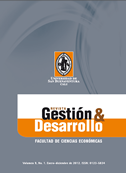La Revista Gestión & Desarrollo proporciona acceso abierto e inmediato a su contenido, basada en el principio de ofrecer al público un acceso libre a las investigaciones para ayuda a un mayor intercambio global de conocimiento.
Excepto que se establezca de otra forma, el contenido de esta revista cuenta con una licencia Creative Commons Attribution-NonCommercial-NoDerivatives 4.0 International (CC BY-NC-ND 4.0) que puede consultar en http://creativecommons.org/licenses/by-nc-nd/4.0/
- Attribution — You must give appropriate credit, provide a link to the license, and indicate if changes were made. You may do so in any reasonable manner, but not in any way that suggests the licensor endorses you or your use.
- NonCommercial — You may not use the material for commercial purposes.
- NoDerivatives — If you remix, transform, or build upon the material, you may not distribute the modified material.
- No additional restrictions — You may not apply legal terms or technological measures that legally restrict others from doing anything the license permits.
Abstract
Through a spatial analysis, this article answers the following question: what is the relationship between municipal management with spatial uneven development? The results shown here correspond to the first phase of a research that relates the variables that determine the difference in the quality of life in the Colombian space. The paper provides an overview of economic development measured by several welfare indicators, which are contrasted with the general municipal performance through specific indicators for its evaluation and measurement. Afterwards, when these data are raised to georeferencing levels, it is found relations and spatial patterns of agglomeration which contribute to the debate on the effects of decentralization and institutional efficiency in the welfare of the communities in a specific territory. Evidence suggests that a better performance in the allocation of resources and the efficient production of goods and services to communities, set prosperous neighborhoods in the Colombian sub space.
References
– BOISIER Sergio. Desarrollo (local): ¿De qué estamos hablando? Santiago de Chile, 1999.
– Corporación Andina de Fomento (CAF). Desarrollo local: hacia un nuevo protagonismo de las ciudades y regiones. Reporte de economía y desarrollo, 2010.
– CAPELLO, R. (2006). “La economía regional tras cincuenta años: desarrollos teóricos recientes y desafíos futuros”. En: Investigaciones regionales, No. 9, pp.169-192.
– CEPAL. La hora de la desigualdad. Brechas por cerrar, caminos por abrir. Trigésimo tercer periodo de sesiones de la CEPAL. Brasilia, 30 de mayo a 1 junio de 2010.
– CHASCO, C. (2003). Econometría espacial aplicada a la predicción-extrapolación de datos microterritoriales. Comunidad de Madrid: Consejería de Economía e Innovación Tecnológica Departamento Nacional de Planeación (DNP).
– GALVIS A. (2001). La topografía económica de Colombia. Bogotá: Banco de la República.
– GALVIS A, y MEISEL, R. (2010). Persistencia de las desigualdades regionales en Colombia: un análisis espacial. CEER. Banco de la Republica.









